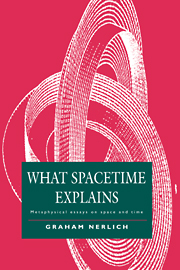Book contents
- Frontmatter
- Contents
- Preface
- Introduction
- Part One Ontology and methodology in relativity
- 1 On Learning from the mistakes of Positivists
- 2 What ontology can be about with Andrew Westwell-Roper
- 3 Special Relativity is not based on causality
- 4 Simultaneity and convention in Special Relativity
- 5 Motion and change of distance
- Part Two Variable curvature and General Relativity
- Part Three Time and causation
- Bibliography
- Index
4 - Simultaneity and convention in Special Relativity
Published online by Cambridge University Press: 19 October 2009
- Frontmatter
- Contents
- Preface
- Introduction
- Part One Ontology and methodology in relativity
- 1 On Learning from the mistakes of Positivists
- 2 What ontology can be about with Andrew Westwell-Roper
- 3 Special Relativity is not based on causality
- 4 Simultaneity and convention in Special Relativity
- 5 Motion and change of distance
- Part Two Variable curvature and General Relativity
- Part Three Time and causation
- Bibliography
- Index
Summary
Introduction
What physics books are apt to say about SR (Special Relativity) is not quite the same as what philosophy books are apt to say about it, as Wesley Salmon points out in his excellent Space, Time and Motion (1975, p. 113). He explains this difference reasonably enough, as due to disparate main interests which SR has for physicists as against philosophers. The former want to develop quickly an apparatus which allows the clear, deft portrayal of central principles and results in physical prediction and explanation. The latter prefer a more leisured approach to this goal so as to give scope for a deeper insight into the semantic-syntactic structure of SR. Most philosophy books say that the language of SR has various conventional elements in it, which means that the theory can have no very simple relation between its syntax and its semantics. In particular, the matter of the simultaneity of space-like separated events is settled conventionally, and this gives rise to a contrast in SR between sentences which form a factual core (Winnie 1970, p. 229; Salmon 1975, p. 117) and others which make up a periphery of non-factual sentences with a merely syntactic function. In what follows I ignore the problem of what other conventions might have a place in SR. I want to examine and reject just this idea that simultaneity is a convention, as this gives rise to the idea that we can contrast a core of factual sentences of SR with a periphery of merely conventional ones.
Wesley Salmon's thought on this central problem is certainly conventionalist. Besides its admirable clarity and precision, Salmon's work contains many valuable arguments and observations on the structure of SR.
- Type
- Chapter
- Information
- What Spacetime ExplainsMetaphysical Essays on Space and Time, pp. 91 - 118Publisher: Cambridge University PressPrint publication year: 1994



